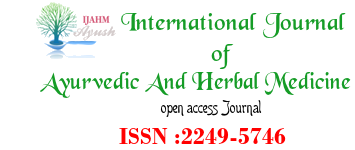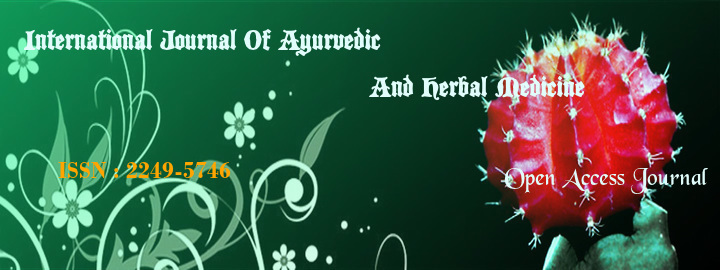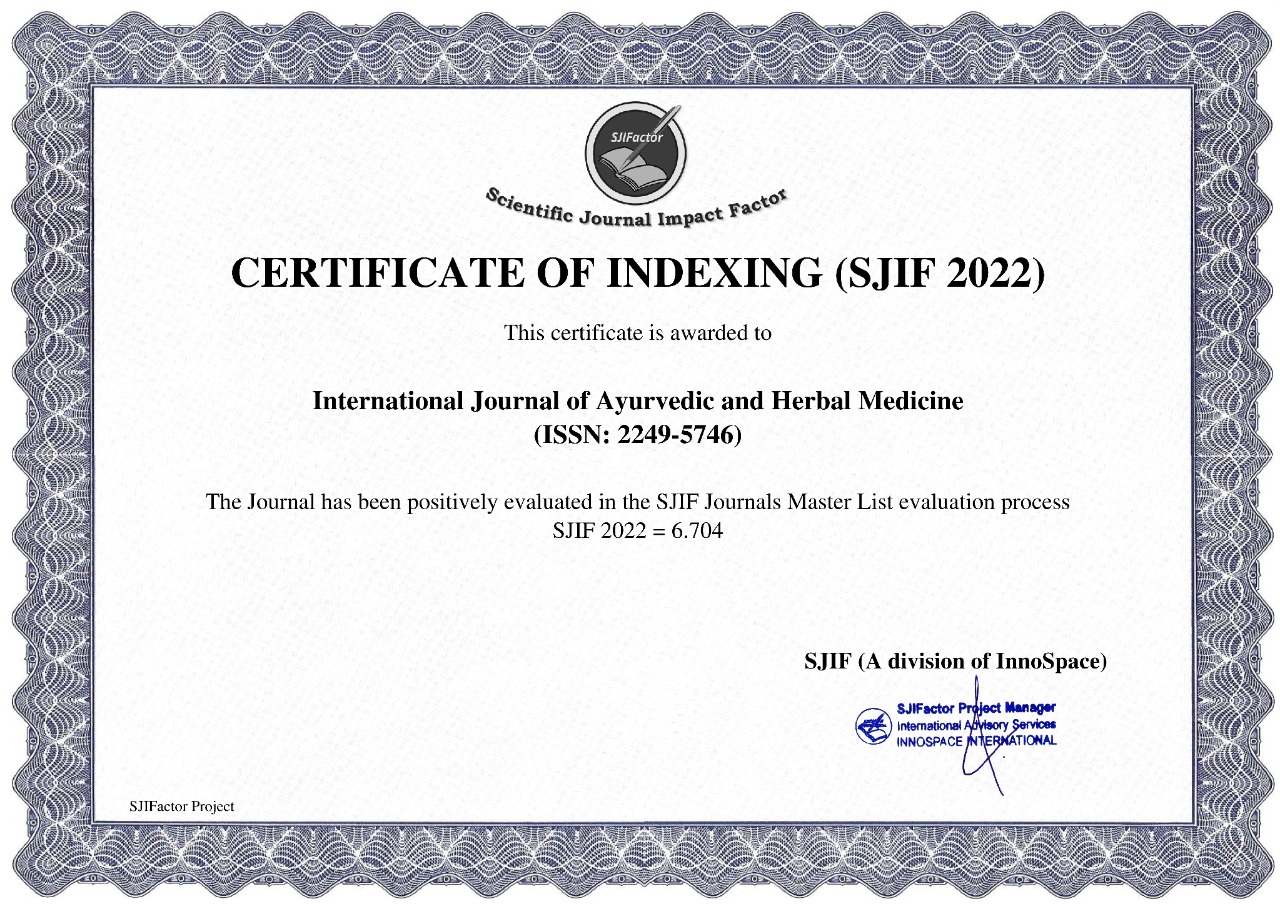


1Jemimma, H. L., 2Arumugasamy K , 3Nantha Kumar. R. , 4Abdul Kaffoor H.
DOI : http://dx.doi.org/10.18535/ijahm/v7i4.06
Department of Botany, Kongunadu Arts and Science College (Autonoumous), Coimbatore, Tamilnadu, India
ABSTRACT:
Objective: The objective of this research is to determine the possible bioactive components of the root and aerial parts of Phyllanthus vaukii using GC-MS analysis.
Methods: The GC-MS analysis of these extracts were performed using a Perkin-Elmer GC Clarus 500 system and Gas chromatograph interfaced to a Mass spectrometer (GC-MS) equipped with a BR-5MS, fused silica capillary column (30mm × 0.25mm 1D × 0.25 µMdf, composed of 5% Diphenyl / 95% Dimethyl poly siloxane).
Results: From P. vasukii root and aerial parts, thirty (30) and twenty seven (27) components were identified respectively. Of the 30 compounds eluted from the root extract, stigmasterol had the highest peak area of 18% and the lowest was n-Propyl 11-octadecenoate showing 0.38%. In the aerial extract 1,2,3-Benzenetriol had the highest peak area of 31.65% and Z,Z-3,15-Octadecadien-1-ol acetate with the lowest peak area of 0.19%. These results indicate the ethanol extract of P. vasukii aerial and root parts possess potent antioxidant, hepatoprotective, anti-inflammatory, antiarthritic, antioxidant, anticancer, Immunostimulant, antitumour, cancer preventive, antiarthritic, antidiabetic, antimicrobial effects so that it can be recommended as a plant of pharmaceutical importance.
Conclusion: However, isolation of individual phytochemical constituents may proceed to find a novel drug or lead compound.
Keywords- Phyllanthus vasukii (P.vasukii), Gc-Ms Analysis, Bioactive Compound, root and aerial parts, ethanolic extract
Reference
1. Zaidan M, Rain N, Badrul A. In vitro screening of five local medicinal plants for antibacterial activity using disc diffusion method. Trop. Biomed. 2005; 22:165-170.
2. Parvathi S. Antimicrobial activity of some traditional medicinal plants. J. Med. Plant Res. 2010; 4:316-321.
3. Wink D, Vodovotz Y, Grisham M, DeGraff W, Cook J, Pacelli R. Antioxidant effects of nitric oxide. Methods Enzymol. 1999; 301:413-424.
4. Janakiraman N, Johnson M, Sahaya SS. GC-MS analysis of bioactive constituents of Peristrophe bicalyculata (Retz.) Nees (Acanthaceae) Asian Pac. J. Trop. Biomed 2012; S46–S49.
5. Kokwaro JO, Medicinal plants of east Africa, First Edition, East Africa Literature Bureau, Nairobo, 1976, 58-59.
6. Sheeja K, Kuttan G. Activation of cytotoxic T lymphocyte responses and attenuation of tumor growth in vivo by Andrographis paniculata extract and andrographolide. Imunopharmarcol immunotoxicol. 2007; 29:81-93.
7. Mukherjee PK, Kumar V, Houghton PJ. Screening of Indian Medicinal Plants for acetyl cholinesterase inhibitory activity. Phytother. Res. 2007; 21:1142-1445.
8. Poompachee K and Chudapongse N. Comparison of the antioxidant and cytotoxic activities of Phyllanthus virgatus and Phyllanthus amarus extracts. Medical Principles and Practice, 2011; 21(1): pp. 24–29.
a. Moreira J, Klein-Júnior LC, CechinelFilho V and De Campos Buzzi F. Anti-hyperalgesic activity of corilagin, a tannin isolated from Phyllanthus niruri L. (Euphorbiaceae). Journal of Ethnopharmacology, 2013;146(1): 318–323.
9. Omulokoli E, Khan B and. Chhabra SC. Antiplasmodial activity of four Kenyan medicinal plants. Journal of Ethnopharmacology, 1997;56(2):133–137.
a. Muthulakshmi A, Margret JR, Mohan VR. GC-MS Analysis of Bioactive components of Feonia elephantum correa (Rutaceae). J. App. Pharm. Sci. 2012; 2 (2):69-74.
b. Kalay E, Yigit G, Aslan Y, Brown KE, Pohl E, Bicknell LS et al. CEP152 is a genome maintenance protein disrupted in Seckel syndrome. Nat Genet. 2011;43:23-6.
c. Om Prakash Tiwari, Yamini B, Tripathi. Antioxidant properties of different fractions of Vitex negundo Linn, Food Chem. 2007; 100(3): 1170- 1176
10. Akram, N.A., M. Ashraf and F. Al-Qurainy. Aminolevulinic acid-induced regulation in some key physiological attributes and activities of antioxidant enzymes in sunflower (Helianthus annuus L.) under saline regimes. Sci. Hort. 2012; 142: 143-148.
a. Mamza, U.T., Sodipo, O.A. and Khan, I.Z. Gas Chromatography-Mass Spectrometry (GC-MS) analysis of bioactive components of Phyllanthus amarus leaves. Int. Res. J. Plant Sci. 2012; 3 (10):pp.208-215.
b. Unander DW, Webster GL, Blumberg BS. Records of usage or assays in Phyllanthus (Euphorbiaceae). I. Subgenera Isocladus, Kirganelia, Cicca and Emblica. J Ethnopharmacol. 1990; 30: 233-264.
c. Unander DW, Webster GL, Blumberg BS. Uses and bioassays in Phyllanthus (Euphorbiaceae): a compilation II. The subgenus Phyllanthus. J Ethnopharmacol. 1991; 34: 97-133.
11. L. Nahar, S. D. Sarker, and A. Delazar, Phytochemistry of the genus Phyllanthus in Phyllanthus Species. Scientific Evaluation and Medicinal Applications, R. Kuttan and K. B. Harikumar, Eds., , Taylor and Francis Group, CRC Press, London, UK, 2011. pp. 119–138
12. K. Shanker, M. Singh, V. Srivastava, R. Verma, A. Gupta, and M. Gupta. Simultaneous analysis of six bioactive lignans in Phyllanthus species by reversed phase hyphenated high performance liquid chromatographic technique. Acta Chromatographica. 2011; vol. 23, no. 2, pp: 321–337.
13. D. F. P. Leite, C. A. L. Kassuya, T. L. Mazzuco et al. The cytotoxic effect and the multidrug resistance reversing action of lignans from Phyllanthus amarus. Planta Medica. 2006; vol. 72, no. 15, pp: 1353–1358.
14. S. K. Sharma, S. M. Arogya, D. H. Bhaskarmurthy, A. Agarwal, and C. C. Velusami. Hepatoprotective activity of the Phyllanthus species on tert-butyl hydroperoxide (t-BH)-induced cytotoxicity in HepG2 cells. Pharmacognosy Magazine. 2011; vol. 7, no. 27, pp: 229–233.
15. K. Tripathi, R. K. Verma, A. K. Gupta, M. M. Gupta, and S. P. S. Khanuja. Quantitative determination of phyllanthin and hypophyllanthin in Phyllanthus species by high-performance thin layer chromatography. Phytochemical Analysis. 2006; vol. 17, no. 6, pp: 394–397.
a. Huang ST, Yang RC, Yang LJ, Lee PN, Pang . JHS: Phyllanthus urinaria triggers the apoptosis and Bcl-2 down-regulation in Lewis lung carcinoma cells. Life Sci 2003;72: 1705–1716.
16. T. K. Nara, J. Glyeye, E. L. Cerval et al., Flavonoids of Phyllanthus niruri, Phyllanthus urinaria, Phyllanthus orbiculatus. Plantes Médicinales et Phytothérapie. 1977; vol. 11: pp: 82–86.
a. L. Yeap Foo and H. Wong. Phyllanthusiin D, an unusual hydrolysable tannin from Phyllanthus amarus. Phytochemistry. 1992; vol. 31, no. 2: pp: 711–713.
index























